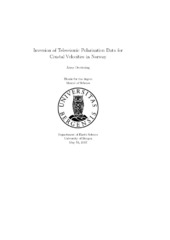Inversion of Teleseismic Polarization Data for Crustal Velocities in Norway
Master thesis
Permanent lenke
https://hdl.handle.net/1956/16420Utgivelsesdato
2017-06-23Metadata
Vis full innførselSamlinger
- Department of Earth Science [1034]
Sammendrag
To characterize the crustal and upper mantle structure it is possible to perform a joint inversion of receiver functions and apparent S-velocities. The inversion is performed using a linearized weighted iterative least-squares inversion and estimates the S-velocity structure. By inverting for two data types the non-uniqueness and the non-linearity of the solution is reduced. In this thesis the inversion method is automated to be applicable on large data sets through testing on synthetic data. The tests were done on different inversion parameters, to find the definitions giving the best results. The most important inversion parameters were the weights, the starting model and how the number of iterations was determined. Several situations for each of these were compared to find the definitions which automated and optimized the inversion. After the tests were done on the synthetic data, they were shortly repeated on real data from a single station. This confirmed that the inversion parameters found were optimal for real data as well. After that the inversion was performed on data from stations in Scandinavia. The results for Scandinavia was compared to results from other studies, showing that this automated joint inversion provide well resolved results displaying complex structures without smoothing. Issues with the estimated results were only apparent when the data had a high signal-to-noise ratio, or if the maximum amplitude peak in the receiver function did not correspond to the Moho discontinuity.
